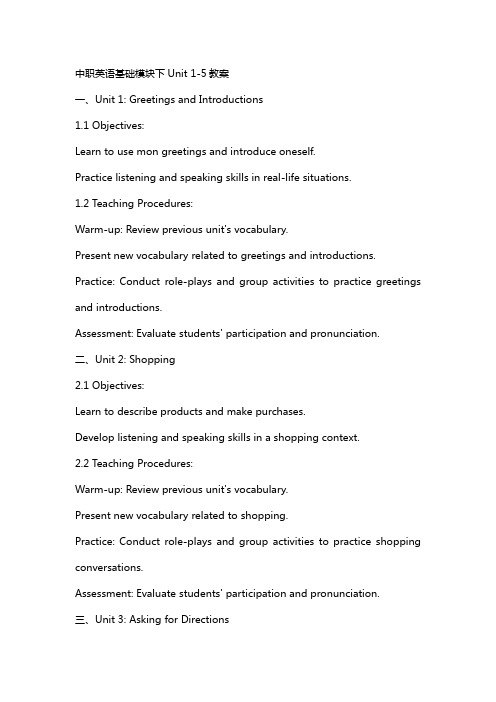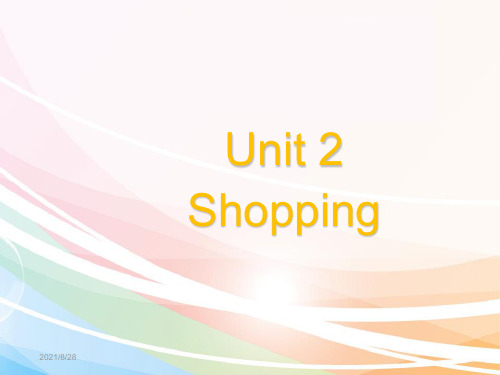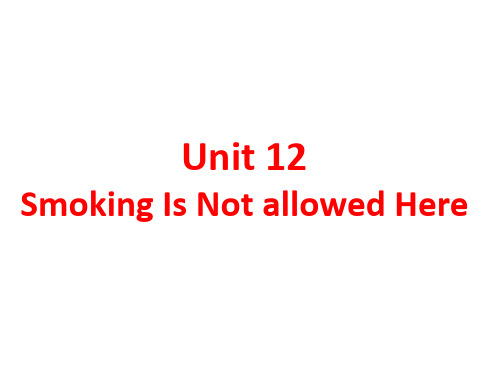优选中职英语基础模块下unit
Unit1职中英语基础模块下册英语课件

教学内容:是否符合教学目标和要求 教师素质:教学态度、表达能力、课堂掌控能力等 教学方法:是否能够激发学生的学习兴趣和思考能力 教学资源:教材、课件、实验设备等是否充足和合适
教学目标:提高学生英语应用能 力
教学方法:采用多种教学方法, 如情景教学、任务型教学等
添加标题
添加标题
添加标题
添加标题
教学内容:以实际应用为导向, 注重听说读写各方面训练
定义:通过模拟真实场景来教授 英语
方法:使用道具、角色扮演等方 式模拟实际情境
添加标题
添加标题
添加标题
添加标题
目的:帮助学生更好地理解和应 用英语
优势:增强学生学习兴趣,提高 英语应用能力
目的:帮助学生更好地理解 和应用英语,增强学习兴趣 和自信心。
定义:学生通过扮演各种角 色来模拟真实情境,从而提 高口语表达能力。
教学评估:定期进行测试和评估, 及时调整教学策略
任务型教学法:以学生为中心,通过完成真实任务来提高语言运用能力。 情景教学法:创设真实或模拟的情景,让学生在情境中学习语言。 游戏教学法:利用游戏激发学生的学习兴趣,让学生在轻松愉快的氛围中学习英语。 合作学习法:通过小组合作,培养学生的协作精神和沟通能力,同时促进学习成绩的提高。
观察法:通过观察学生的表现,评估学生的学习进展和问题 测验法:通过定期的测试和考试,检测学生对知识的掌握程度 作品评价法:对学生的作品或成果进行评价,了解学生的学习效果和创造力 自我评价法:引导学生进行自我评价,培养他们的自我反思和自我管理能力
表达能力
情境模拟:通 过模拟真动:布 置具体任务, 促使学生主动 探究和合作学
习
游戏化教学: 将学习内容融 入游戏中,激 发学生学习兴
中职教育-《英语基础模块(下册)》unit5.ppt

Listen and answer.
Dialogue A A Halloween Party
9
Listen and answer.
( ) ① seeing a Halloween movie ( ) ② telling ghost stories ( ) ③ dress-up ( ) ④ haverent kinds of beer ( ) ⑤ knocking at the neighbor’s door and asking for candies
14
Listen and read.
Dialogue B Christmas is coming.
Emma: It’s the Chinese New Year. It falls on the first day of the first lunar month and lasts for fifteen days.
Paul: It sounds very complicated. Emma: Yes. It doesn’t have a fixed date. Paul: How do you celebrate it? Emma: We usually get together to have a family reunion dinner and pay visits to our
Grammar Focus Have Fun Review
过渡页
TRANSITION PAGE
Part 1 Warm up
→ Look and match.
4
→ Look and match.
5
→ Look and decide.
6
→ Match.
中职英语-基础模块-下-unit 5 reading[优讲课堂]
![中职英语-基础模块-下-unit 5 reading[优讲课堂]](https://img.taocdn.com/s3/m/dafe422b8e9951e79b8927ef.png)
stay away from 离开,缺席 stay away from school 逃课 The student who stayed away from school will be punished.
课资讲解
21
2. … I’ll have to run away from home again.
课资讲解
23
4. Joe suddenly took the note out of his pocket and threw it away. throw… away 把……扔掉
Don’t throw the bottle away anywhere, put it into the dustbin. 不要把瓶子到处乱扔,放
5. Bill realized his mistake. T
课资讲解
26
Phrases in Part II. (Para 5-Para 7.) 1.… Bill woke and found Joe sitting up in bed, crying.
sit up
坐起来
We sat up drinking and talking 我们饮酒谈天,直至深夜。
你不为什么不上楼去躺一会儿呢?
课资讲解
31
6. He went straight to the big tree and carefully climbed up onto the branch to take the note back.
and asked Bill’s brother Joe to take it home.
C. Bill stayed away from school one hot day and
中职英语基础模块下unit全部教案

中职英语基础模块下Unit 1-5教案一、Unit 1: Greetings and Introductions1.1 Objectives:Learn to use mon greetings and introduce oneself.Practice listening and speaking skills in real-life situations.1.2 Teaching Procedures:Warm-up: Review previous unit's vocabulary.Present new vocabulary related to greetings and introductions. Practice: Conduct role-plays and group activities to practice greetings and introductions.Assessment: Evaluate students' participation and pronunciation.二、Unit 2: Shopping2.1 Objectives:Learn to describe products and make purchases.Develop listening and speaking skills in a shopping context.2.2 Teaching Procedures:Warm-up: Review previous unit's vocabulary.Present new vocabulary related to shopping.Practice: Conduct role-plays and group activities to practice shopping conversations.Assessment: Evaluate students' participation and pronunciation.三、Unit 3: Asking for Directions3.1 Objectives:Learn to ask for and give directions.Improve listening and speaking skills in a navigation context.3.2 Teaching Procedures:Warm-up: Review previous unit's vocabulary.Present new vocabulary related to asking for directions.Practice: Conduct role-plays and group activities to practice asking for directions.Assessment: Evaluate students' participation and pronunciation.四、Unit 4: Hobbies and Interests4.1 Objectives:Learn to describe hobbies and interests.Enhance listening and speaking skills in a leisure context.4.2 Teaching Procedures:Warm-up: Review previous unit's vocabulary.Present new vocabulary related to hobbies and interests.Practice: Conduct role-plays and group activities to practice describing hobbies and interests.Assessment: Evaluate students' participation and pronunciation.五、Unit 5: Family and Friends5.1 Objectives:Learn to describe family members and friends.Strengthen listening and speaking skills in a personal relationship context.5.2 Teaching Procedures:Warm-up: Review previous unit's vocabulary.Present new vocabulary related to family and friends.Practice: Conduct role-plays and group activities to practice describing family members and friends.Assessment: Evaluate students' participation and pronunciation.这只是一个初步的教案框架,您可以根据具体的教学需求和时间进行调整和补充。
中职英语基础模块下unit(ppt)

ZhaLaite vocational school
Classroom building
reading room
playground
dining-hall
dormitory
Learning target学习目标
1.知识目标 学会运用welcome to, be glad to do, look at , a lot of, next to 等重点词组
4. Many students play__b_a_s_k_e_tb_a_l_l_ and _f_o_o_t_b_a_ll_ on the playground after class every day.
Task2 Careful reading
1.welcome to… “欢迎到……来”。
如:欢迎到北京来。 _W_e_lc_o_m_e_t_o_B_e_iji_n_g!__
D. to
7. There is a big _____ in our school.
A. dine hall B. dining-hall C. dining D. dined
8.The students all__________ in this school.
A. study hardly
B. hardly study
5. _____ the blackboard and read these new words
A. Look B. See C. Look at D. Look in
6. Our classroom building is ____ the library.
A. next to B. next on C. at
D. gone
中职英语基础模块下册Unit 4 At the Hotel

I. Listen to the recording and tick the word you've just heard in each sentence.
Group 1 /ʊə/ and /aʊə/
Script (1) A poor man came to the house this morning,
To be continued
Notes
5. I hope everything will be fine this time. 我希望这次一切顺利。 此句中hope后是一个省略that的宾语从句。hope意为“希望”, 强调主观上的希望,其后可接不定式做宾语或接that引导的宾 语从句。例如:
We hope to visit Summer Palace soon. 我们希望很快去颐和园游玩。 Our foreign friends hope that they can join the May Day celebrations in
其基本含义有两种: (1) 意为“我们 (终于) 到了”。其后可跟地点状语。例如: Here we are at the station. 我们终于到站了。 (2) 意为“我们所需要的 (或所要找的) 东西就在这里”。当谈论中的
东西是单数时可替换为Here it is,是复数时可替换为Here they are 。例如: —Where is our dictionary? 我们的字典在哪儿? —Here we are./Here it is. 在这里。 —Where are our books? 我们的书在哪儿呢? —Here we are./Here they are. 在这儿。
Bob about the turn-down service.
中职英语基础模块下册unit2

8.What color does your wife prefer? prefer 宁愿,更愿意
eg. -Which do you prefer, tea of coffee?
-Either. Thank you prefer+名词+to+名词 “喜欢…而不喜欢…
eg. The old man preferred living in the countryside to living
eg. Your coat is out of coat. 5. What size does your wife wear?
size 尺寸 类似表达:what color/ what time
eg. What color is it?
What time is it?
6. Extra large
超大号 完整陈述:She needs an extra large blouse. extra 副词,特别地,超出一般地,用来修饰large
2021/8/28
Zhang Ling, a guide, is leading Mr. Wallace to do some shopping. Now, let’s read and try to know where they will go and what Mr. Wallace
will buy.
sign [sain] n. 签名 v. 签名 receipt [rɪ‘siːt] n. 收据,发票 final [‘faɪn(ə)l] adj.最终的,最后的
perfect [‘pɜ:fɪkt] adj. 完美的,正 确的 quite [kwaɪt] adv. 完全地,十分, 相当
中职英语基础模块(下册)Unit-7课文翻译

For some people, smoking has become a daily habit. They think that smoking makes them feel happy and helps them relax. What makes things worse is that some famous actors show smoking on TV. This makes people think that smoking is cool and is a fashion of the day. Those ideas are foolish and wrong.
在很多国家, 人们在办公室已经不 准吸烟了,
Smoking Is Not allowed Here
In many counห้องสมุดไป่ตู้ries, people can’t smoke in the office any more and they can’t smoke even within the building. Department stores and restaurants are also becoming smoke-free. It won’t be very long before smoking is not allowed anywhere in public areas.
他们认为吸烟能让他们感到高兴,帮 他们放松。
For some people, smoking has become a daily habit. They think that smoking makes them feel happy and helps them relax. What makes things worse is that some famous actors show smoking on TV. This makes people think that smoking is cool and is a fashion of the day. Those ideas are foolish and wrong.
- 1、下载文档前请自行甄别文档内容的完整性,平台不提供额外的编辑、内容补充、找答案等附加服务。
- 2、"仅部分预览"的文档,不可在线预览部分如存在完整性等问题,可反馈申请退款(可完整预览的文档不适用该条件!)。
- 3、如文档侵犯您的权益,请联系客服反馈,我们会尽快为您处理(人工客服工作时间:9:00-18:30)。
C. hard study
D. study hard
1_W__e_lc_o_m__e_t_o_(欢迎到) our home. Come in, please. 2.I _a_m__v_e_r_y_g_l_a_d_(很高兴) to study at this school. 3. Our school is a very good__v_o_c_a_ti_o_n_a_l_s_c_h_o_o_l(职 业学校). 4.There is a lab_n_e_x_t_to_(紧挨着) our classroom. 5. The students usually read and study in the school library_a_f_te_r__cl_a_s_s_(课后).
1.Li Lei is a _n_e_w__s_t_u_d_e_n_t_of this school.
2. Li Lei’s classroom is on the third __fl_o_o_r__ and it is _la_r_g_e_ and _b_r_ig_h_t_.
3. There are four_r_e_a_d_i_n_g_r_o_o_m__s_in the school library.
e.g. Thank you for your help. 谢谢你的帮助。
9. See you next time. 下次见;欢迎再来 也可简说See you!
1. Hello, John! Welcome _____ Shijiazhuang!
A. at B. to
C. in
D. /
2. I’ll be glad ____ with you.
2. 能力目标 训练快速捕捉信息和准确的辨听能力,培养
阅读理解能力和技巧,并能够用简单的语句介 绍自己的班级和学校。
3.情感目标 培养学生懂礼貌,守礼仪,和热爱学校,热
爱班级的集体主义精神。
Task1 Fast reading Listen to the tape and fill in the blanks
ZhaLaite vocational school
Classroom building
reading room
playground
dining-hall
dormitory
Learning target学习目标
1.知识目标 学会运用welcome to, be glad to do, look at , a lot of, next to 等重点词组
2. be glad to do sth “很高兴做某事” 如:我很高兴见到你。 _I__a_m__g_la_d__to__se_e__y_o_u_. 3. There are sixty classrooms…in this building.
There are fifty students in our class. There are a lot of books in it. There are four reading rooms in the library. There is a large dining-hall and many bedrooms in it.
There be…"某处(存在)有…" 动词be随主语的数而变化,主语为单数时用is, 复数时用are.句尾通常有表示地点的状语。
4. a lot of =lots of +可数或不可数名词 “很多,大量的”。 e.g.You can see a lot of cars in the street.
优选中职英语基础模块下unit
Review 复习
1.欢迎到…来 2.很高兴做… 3.看… 4.教学楼 5.许多… 6.阅览室 7.课后 8.靠近;紧挨着 9.餐厅 10.为…而感谢…
welcome to…
be glad to do… look at classroom building a lot of reading room after class next to dining-hall thank… for…
D. to
7. There is a big _____ in our school.
A. dine hall B. dining-hall C. dining D. dined
8.The students all__________ in this school.
A. study hardly
B. hardly study
4. Many students play__b_a_s_k_e_tb_a_l_l_ and _f_o_o_t_b_a_ll_ on the playground after class every day.
Task2 Careful reading
1.welcome to… “欢迎到……来”。
如:欢迎到北京来。 _W_e_lc_o_m_e_t_o_B_e_iji_n_g!__
5. _____ the blackboard and read these new words
A. Look B. See C. Look at D. Look in
6. Our classroom building is ____ the library.
A. next to B. next on C. at
A. to go B. going C. go
D. gone
3. My house is ____ the fifth floor.
A. in B. at
C. into D. on
4. There are ____ students on the playground.
A. a lot B. a lots of C. a lot of D. lot of
在街上,你能见到许多汽车。
5. next to “紧挨着”。
如:图书室紧挨着我们的教室。
Reading room is next to our classroom.
6. This way, please. 请走这边。
7. Here we are! 我们到了! 8. thank…for… 为….而感谢某人
